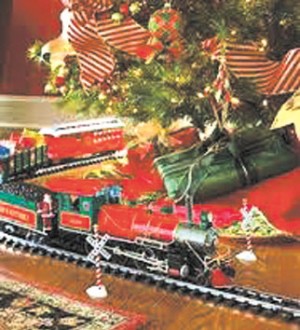This column last appeared in December 2011.
Even though we may only realize it in retrospect, children often display behavior very early in life that points to their destiny. In the early 1890s seven year old Joshua Lionel Cowen whittled a miniature locomotive from a scrap of wood. It was a remarkable likeness considering his young age. He then tried to fit it with a tiny engine — and it exploded. He was unharmed, but his mother’s kitchen sustained considerable damage. Many years later, in his early twenties, he would try the experiment again. This time he met with success, and the model train was born.
Cowen sold his first model train to a Manhattan shop owner in 1901, by convincing him the small train running through his Christmas window display would draw attention to his other merchandise. The shop owner returned the next day to order half a dozen more tracks and trains. It appeared while the merchandise in his window was getting attention, the customers main question was “where can we buy the train?” Lionel quickly provided the shop with a dozen train sets consisting of one electric flat car and thirty feet of track and dubbed it the “Electric Express.” Within twelve months Cowen acquired enough capital to start his own company, The Lionel Corporation.
Though a prolific inventor, Cowen’s marketing skills would prove just as valuable to his success. Working from a German tradition, linking toy trains to Christmas, Cowen approached a number of large department stores in New York City, convincing them to incorporate elaborate train setups around their Christmas tree displays. He provided the trains, tracks, building and landscapes. Sales boomed, and America had officially entered the Golden Era of Toy Trains.
The years brought many changes as Cowen constantly improved upon his original concept. In 1902 a train set with a “City Hall Park” trolley and a two foot suspension bridge met with great success. The year 1903 saw the introduction of the B&O locomotive and the motorized Derrick car. And in 1906 Lionel added a third rail which carried the current and the outer rails, which were the ground rails. Three trolleys, two steam engines, two passenger cars, seven freight cars and a small wall transformer completed this ground-breaking set.
In 1929, Cowen unveiled the “Transcontinental Limited,” which stretched nine feet from its massive headlight to its ornate observation platform. It cost an unheard off $110, more than price of a used Model T. Lionel was at the peak of their success when the Depression of the early 1930s hit. As people struggled to feed their families, few had money to spend on toys. Obtaining government contracts for his other manufacturing concerns, Cowen managed to keep the Lionel Corporation afloat.
The metal shortage of the early 1940s forced Lionel to step up their production of plastic trains and accessories. When the manufacture of metal trains resumed in the mid-1940s, Lionel produced what are considered by many to be the best in their long company history.
By the mid-1950s, public interest had shifted from trains to airplanes and slot-cars. Christmas of 1953 saw the first considerable drop in sales and by January of 1965 the Lionel Train Corporation closed. Until next time . . . Linda
Linda Kennett may be reached at 317-258-7835 or lkennett@indy.rr.com



